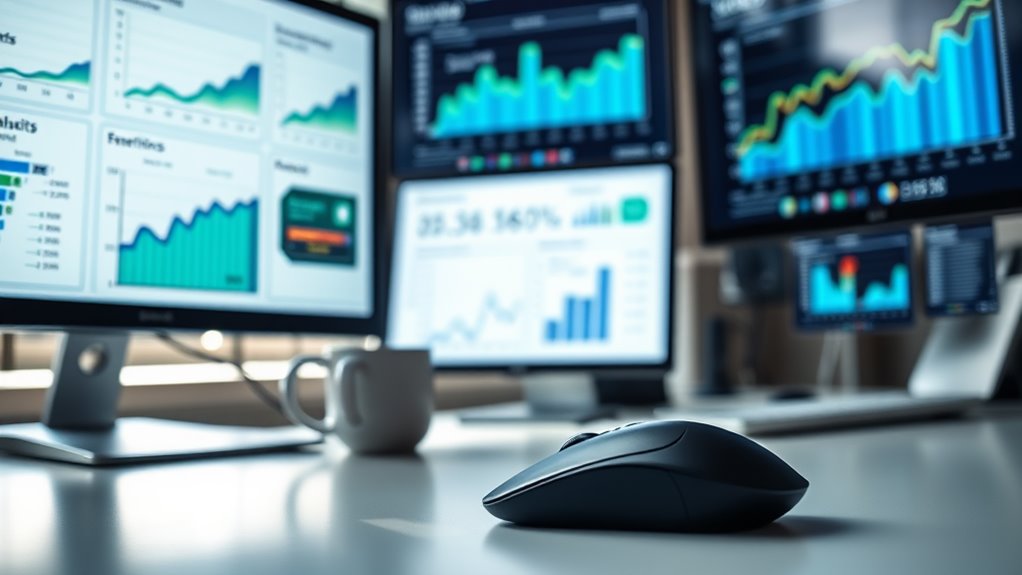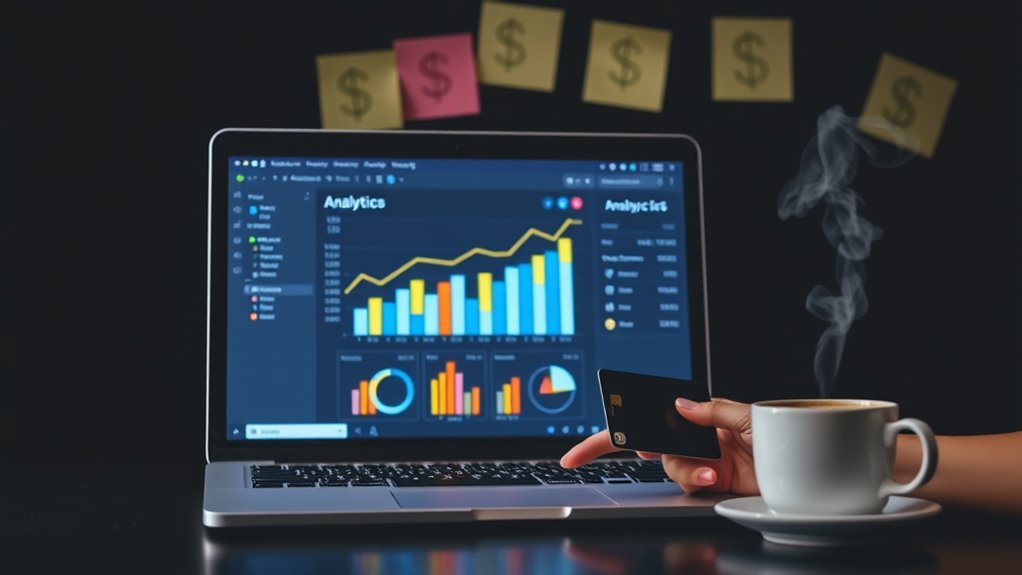You should expect to pay between $2,000 to $15,000 for a professionally built Shopify website, with most projects falling in the $5,000 range. The cost depends on your specific needs, from basic theme customization ($500-$2,500) to full custom development ($8,000+). Key factors affecting price include custom design work, product management systems, payment integrations, and security features. While DIY options start at just $29 monthly for Shopify's basic plan, professional development guarantees proper setup, optimization, and functionality. Monthly maintenance costs typically run $50-200 for updates and security. Understanding the complete pricing breakdown will help you make a smarter investment decision.
Key Takeaway
- Basic Shopify website development typically costs between $2,000-$15,000, depending on complexity and developer expertise.
- DIY setup saves money ($29-$79 monthly) but requires 40-60 hours of personal time investment.
- Professional packages range from basic ($500-$2,500) to premium ($8,000-$25,000+), with varying levels of customization and features.
- Custom theme development adds $1,000-$5,000, while third-party integrations cost $200-$800 each.
- Factor in ongoing costs like platform fees ($348-$3,588 annually), app subscriptions ($0-$200 monthly), and maintenance expenses.
Understanding Basic Shopify Website Costs
Core Cost Components:
- Platform subscription fees (ranging from $348-$3,588 annually)
- Domain name registration ($14-$30/year)
- Theme costs ($0-$350 for premium themes)
- App integrations ($0-$200+/month)
- Development and customization ($500-$5,000+)
Your initial investment will largely depend on your business requirements and customization needs. A basic setup with minimal customization might cost you around $1,000, while a fully customized store could reach $10,000 or more.
Additional Considerations:
- Transaction fees (2.9% + $0.30 per transaction)
- SSL certificate (included with subscription)
- Content creation ($200-$1,000)
- Marketing integrations ($50-$300/month)
You'll want to budget for both upfront costs and ongoing maintenance expenses. Most businesses find their sweet spot between $2,000-$5,000 for initial setup, with monthly operational costs ranging from $100-$500, depending on your chosen features and integrations.
DIY Vs Professional Development
DIY Development:
- Cost: $29-79 monthly Shopify subscription
- Time investment: 40-60 hours for basic setup
- Learning curve: Moderate, utilizing Shopify's drag-and-drop tools
- Full control over design decisions and timing
- Access to free and premium themes ($150-350)
Professional Development:
- Cost: $2,000-15,000 for custom development
- Timeline: 2-8 weeks for completion
- Expert knowledge of SEO and conversion optimization
- Professional coding and custom functionality
- Ongoing support and maintenance options
Your decision should align with your:
- Technical expertise
- Available time
- Budget constraints
- Business complexity
- Customization needs
If you're launching a straightforward store with standard features, DIY development using Shopify's user-friendly platform might suffice. However, if you need complex customizations, integrated systems, or unique functionality, professional development typically delivers superior results and long-term value, despite higher initial costs.
Pricing Tiers and Service Packages

Professional Shopify developers typically structure their services into distinct pricing tiers that match different business needs and budgets. You'll find that most agencies and freelancers offer packages ranging from basic setups to thorough solutions, with pricing typically falling between $500 and $25,000.
Common Service Tiers:
- Basic Package ($500-$2,500): Includes theme customization, basic product setup, and essential apps integration, ideal for small businesses just starting their e-commerce journey
- Standard Package ($2,500-$8,000): Offers advanced customization, complete product migration, multiple payment gateways, and enhanced SEO optimization
- Premium Package ($8,000-$25,000+): Delivers full-scale custom development, unique feature integration, advanced analytics setup, and thorough marketing tools
When selecting a service tier, you'll need to take into account your store's complexity, growth projections, and immediate needs. Each tier typically builds upon the previous one, adding more sophisticated features and functionality. You can expect higher tiers to include additional services like ongoing support, performance optimization, and advanced security measures, which become essential as your business scales.
Essential Features That Impact Cost
Several key features drive the overall cost of your Shopify website, with each additional functionality adding to the final price tag. Understanding these elements will help you budget effectively and prioritize your essential needs.
Core Features That Affect Price:
- Custom Theme Development ($1,000-$5,000)
- Unique design elements
- Brand-specific layout modifications
- Mobile responsiveness optimization
- Product Management Systems ($500-$2,000)
- Inventory tracking integration
- Multiple variant handling
- Bulk upload capabilities
- Payment and Security Features ($300-$1,500)
- SSL certification
- Multiple payment gateway integration
- Fraud prevention tools
Advanced Functionality:
- Third-party Integrations ($200-$800 per integration)
- CRM systems
- Email marketing platforms
- Analytics tools
- Custom Applications ($1,000-$3,000)
- Loyalty programs
- Subscription services
- Customer portals
Each feature you select will impact your website's final cost, but investing in essential functionalities that align with your business model will provide better long-term value. You'll need to balance immediate budget constraints against future scalability requirements when selecting these features.
Hidden Costs to Consider

Beyond the obvious feature costs of a Shopify website, many unexpected expenses can catch business owners off guard. You'll need to account for several hidden costs that can greatly influence your overall budget when launching your online store.
Hidden Operational Costs:
- Payment processing fees (2.9% + $0.30 per transaction for standard credit card payments)
- Third-party app subscriptions ($10-200 monthly for essential tools like inventory management or email marketing)
- SSL certificate renewals ($70-300 annually, depending on security level)
Your website's maintenance will require ongoing investments beyond the initial setup. You'll need to factor in content updates, product photography, and regular security patches that many business owners overlook during budgeting. Additionally, marketing automation tools, customer support software, and analytics platforms often come with their own subscription fees.
Remember to take into account scalability costs as your business grows. While your initial Shopify plan might start at $29 monthly, you may need to upgrade to advanced plans ($299+) to accommodate increased traffic and sales volume. Data migration, custom integrations, and specialized developer support can also add substantial costs to your e-commerce operation.
Finding the Right Developer
A successful Shopify website's foundation often rests on choosing the right developer for your project. When evaluating potential developers, you'll need to assess their expertise, portfolio, and communication style to guarantee they align with your vision.
Key Qualifications to Look For:
- Proven Shopify experience (minimum 2-3 years)
- Portfolio featuring similar projects to yours
- Positive client testimonials and reviews
- Strong understanding of e-commerce best practices
- Familiarity with your industry or niche
Vetting Process Steps:
- Review their past work, focusing on stores within your price range
- Request detailed proposals outlining timelines and deliverables
- Check references from previous clients
- Assess their communication responsiveness and clarity
- Verify their knowledge of current Shopify features and updates
You'll find developers through various channels, including Shopify's Expert Marketplace, freelance platforms, and agency directories. Expect to interview at least 3-5 candidates before making your decision. Remember to document your requirements clearly and establish milestone-based payments to protect both parties throughout the development process.
When comparing developers, don't automatically choose the lowest bid – consider their experience level, communication style, and project understanding as equally important factors.
Maximizing Your Website Investment

Once you've selected the right developer, making the most of your Shopify website investment becomes your next priority. To guarantee ideal returns, you'll need to focus on strategic implementation and ongoing optimization of your e-commerce platform.
Key Investment Optimization Steps:
- Track essential metrics from day one, including conversion rates, average order value, and cart abandonment rates, to identify areas needing improvement and measure your ROI effectively.
- Invest in high-quality product photography and compelling descriptions, as stores with professional images typically see 30% higher conversion rates compared to those with basic photos.
- Implement a regular maintenance schedule, including monthly security updates, performance optimization, and content refreshes to protect your investment long-term.
You'll want to allocate your budget across various aspects of your store's development, with approximately 60% going toward core functionality, 25% toward design elements, and 15% toward testing and optimization. Consider setting aside an additional 15-20% of your initial investment for post-launch improvements and updates during the first year.
Remember to regularly assess your site's performance against industry benchmarks and make data-driven decisions about future investments in your platform's growth.
Conclusion
Building your Shopify website is like constructing a house – you'll get what you pay for, from basic $500 templates to $10,000+ custom builds. When you're ready to invest, choose a developer who aligns with your budget and vision while considering long-term scalability. Remember, a well-built e-commerce site isn't just an expense; it's an investment that'll serve as your digital storefront for years to come.









